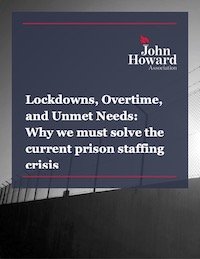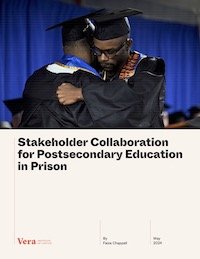By Benjamin Heller Brian King Will McKeithen Chantal Polinsky
Since the New York City Council voted in 2019 to close Rikers Island and replace it with four borough-based jails, corrections officers’ perspectives on their work have been largely absent from the conversation, even though they, too, will be impacted by Rikers’ closure. This report addresses that gap. From November 2023 to February 2024, Vera researchers conducted 30 in-depth interviews with 30 current and former corrections officers. Vera found that working at the New York City Department of Correction (DOC) takes an enormous physical and psychological toll on officers, and many of those interviewed reported that they stayed in the role because they felt it was their only path to financial security. There is an urgent need for city leaders to invest in career transition services to help DOC rightsize its workforce without inflicting economic harm on the current correctional workforce. To that end, Vera also spoke with five New York City-based workforce development experts to identify best practices for transitioning corrections officers to new fields. In addition, the interviews make clear that DOC must equip officers who continue working in the jails with the skills and support they need to maintain their own physical and emotional well-being while ensuring the safety of people incarcerated in the borough-based jails. The interviews led Vera researchers to several key findings: • Officers join DOC for the salary, benefits, and pension—and often feel trapped by them. Every officer interviewed said they joined DOC for the salary, benefits, job security, and path to early retirement. The salary, benefits, and pension at DOC allow officers without college degrees a path to financial stability. However, pathways like this are so rare, and career services so inaccessible, that officers routinely feel trapped in the job. • Harmful working conditions take a toll on officers’ physical and mental health. Officers reported poor physical and mental health as a result of the job. They blamed their intense work schedule for bad eating habits, lack of physical activity, poor sleep hygiene, stress, anxiety, trouble attending medical appointments, and difficulty balancing their work and home lives. As a result, nearly every officer said they would not recommend the job to friends or family. • Officers feel unsupported by management. Many officers said that DOC management does not help staff address physical and mental health needs, either proactively or after issues arise. Some of the officers Vera interviewed remarked that they felt like just a number to DOC. More than one said that management pressured them to return to work after injury before they were medically ready. Others recalled situations in which management urged them to ignore symptoms of trauma, depression, or post-traumatic stress disorder (PTSD) and return to their posts. • Favoritism determines scheduling, and by extension, well-being. Several interviewees said that a culture of favoritism permeates every aspect of the job—from facility and post placement to overtime assignments, misconduct write-ups, meal relief, and promotions. Participants attributed the problematic culture they experienced to leadership and said that it trickled down through the ranks, lowering morale, eroding camaraderie, and increasing absenteeism. • Officers struggle to identify transferrable skills they develop on the job. Interviewees struggled to identify skills they developed at DOC, with some saying they could not think of any skills that would be useful outside of a security setting. When pressed, most officers said their skills included interpersonal communication and situational awareness. • When they leave DOC, most officers stay in the security sector, though their interests are much more varied. Most participants felt that they were only qualified to go into security-related jobs. The majority of officers said they had colleagues who left DOC to join the New York City Police Department (NYPD) or to move to a different state and work for a different corrections department. When asked about their interests and career ambitions, however, interviewees mentioned film production, library sciences, hospitality, education, personal training, real estate, and more. Often, the barrier to pursuing these alternative career paths was not a lack of motivation, but rather a lack of resources and time. • New Yorkers seeking well-paid careers with low barriers to entry need more options. Corrections is one of too few well-paid career opportunities for New Yorkers without postsecondary degrees. Providing career transition services to current officers will help DOC rightsize its uniform workforce, saving public funds while helping officers find new opportunities that do not place such a burden on their health and home lives. There was a clear consensus among workforce development experts that to facilitate these career transitions, city leaders must fund a program that creates a series of talent profiles, maps them onto new career pathways, and mobilizes robust support to help officers successfully reskill themselves and prepare for the next phases of their careers. Such a program should be a model for future initiatives that engage New Yorkers without postsecondary education—who may struggle to find well-paid jobs—at the start of their career searches to connect them with opportunities that lead to well-paid employment. • Officers who continue working at DOC need better training and support to maintain their health and improve conditions in the jails. Officers who remain working in the jails need more support than they currently receive. When asked how DOC could support them more effectively, officers had many ideas. Improved training, particularly when it comes to interacting with people with mental illness; enhanced access to mental health support; equitable processes for assigning officers to posts and overtime; and ongoing feedback mechanisms that allow leadership to hear directly from officers will all help DOC ensure that it is supporting officers’ physical and mental well-being, which in turn may help improve jail conditions for incarcerated people. Ultimately, investing in career transitions for corrections officers is an opportunity to reduce jail spending and invest in community-based solutions that prevent crime in the first place. It can also improve the lives of corrections officers who work for DOC because they feel they have no other options. In addition, supporting officers who remain at DOC may help keep the traumatic conditions of Rikers Island from taking root in the borough-based jails.
New York: Vera Institute of Justice, 2024. 18p.





















